Scalably synthesized environmentally benign, aqueous-based binary nanoparticle inks for Cu2ZnSn(S,Se)4 photovoltaic cells achieving over 9% efficiency†
Abstract
Low-cost materials, scalable manufacturing, and high power conversion efficiency are critical enablers for large-scale applications of photovoltaic (PV) cells. Cu2ZnSn(S,Se)4 (CZTSSe) has emerged as a promising PV material due to its low-cost earth-abundant nature and the low toxicity of its constituents. We present a compact and environmentally friendly route for preparing metal sulfide (metals are Cu, Zn, and Sn) nanoparticles (NPs) and optimize their annealing conditions to obtain uniform carbon-free CZTSSe thin films with large grain sizes. Further, the solution-stable binary NP inks synthesized in an aqueous solution with additives are shown to inhibit the formation of secondary phases during annealing. A laboratory-scale PV cell with a Al/AZO/ZnO/CdS/CZTSSe/Mo-glass structure is fabricated without anti-reflective coatings, and a 9.08% efficiency under AM1.5G illumination is demonstrated for the first time. The developed scalable, energy-efficient, and environmentally sustainable NP synthesis approach can enable integration of NP synthesis with emerging large-area deposition and annealing methods for scalable fabrication of CZTSSe PV cells.



 Please wait while we load your content...
Please wait while we load your content...